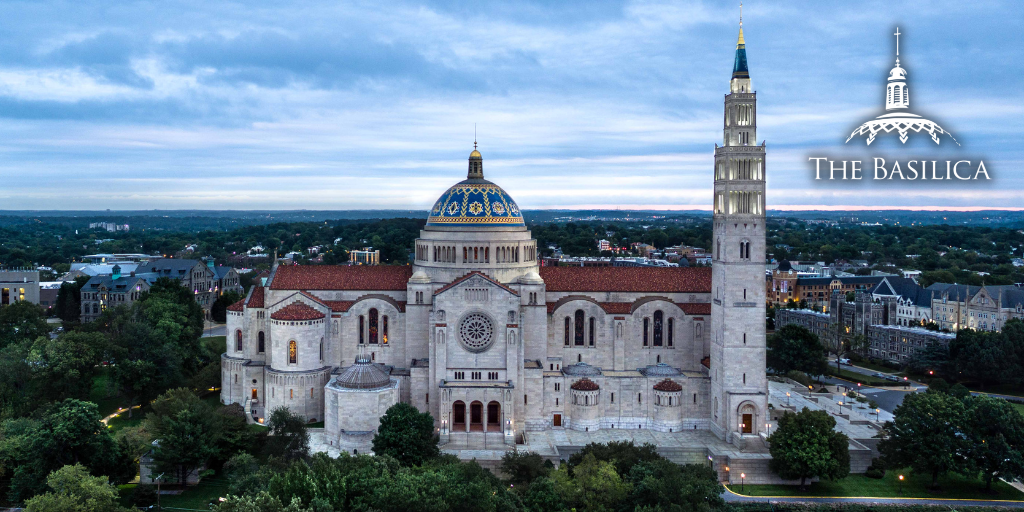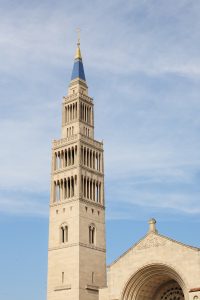
 At 329 feet tall, the Knights Tower is one of the iconic visual hallmarks of the National Shrine. Not only is it visually distinctive, but it also holds the Basilica’s 56-bell carillon, which was installed on July 23, 1963. Since then, its magnificent bells have heralded pivotal moments in the life of America’s Catholic Church – from the solemn remembrance of 9/11 to the jubilant arrival of Pope Francis in 2015.
At 329 feet tall, the Knights Tower is one of the iconic visual hallmarks of the National Shrine. Not only is it visually distinctive, but it also holds the Basilica’s 56-bell carillon, which was installed on July 23, 1963. Since then, its magnificent bells have heralded pivotal moments in the life of America’s Catholic Church – from the solemn remembrance of 9/11 to the jubilant arrival of Pope Francis in 2015.
As the Basilica’s Knights Tower Carillon turns 60 this year, we invite you to learn five fun facts about this iconic instrument.
1. The Knights Tower Carillon bells weigh a staggering total of 37,150 pounds!
The 56 bells of the carillon cover a range of two octaves and vary in weight from 21 lbs. to 7200 lbs. each. While the bronze cast bells are permanent and don’t require maintenance, the mechanical action and the clock-controlled electrical equipment are subject to the effects of age, use, weather, humidity, and pollution. In the summer of 1988, the I.T. Verdin Company of Cincinnati, Ohio, the oldest and largest tower bell company in the United States, constructed new action components, as well as a new clock, control system and keyboard. In addition, new computerized features were added, and the restored carillon was heard for the first time on Christmas Eve in 1988.
2. Each bell is named for a saint and inscribed with text written in the voice of the namesake – a longstanding tradition with carillon bells.

The largest bell, the Mary bell, strikes on the hour and the Christopher, Edward, Francis, and Virgil bells strike on the quarter hours. Because each of the bells is named after a saint, the text on the bell is also meant to reflect something the namesake might say. The Mary bell carries the following text:
Mary is my name.
Mary is my sound.
Beloved Mother
Queen of Heaven and Earth
Queen of this dear land
for knights to God and country bound
and all who hear my voice
I sing the praises of God.
3. The carillon has different harmonics than most instruments, which means that the musical intervals for many standard keyboard pieces will sound different.
While one might assume that any standard keyboard music may be performed on a carillon given the similar layout of the instrument, this is not the case. According to Basilica Carillonneur Dr. Robert Grogan:
“The harmonics of bells are decidedly not the same as they are for strings and wind instruments. While most instruments have major-third harmonics, there is a minor-third in bell harmonics, so the major triads sounded out-of-tune… While some music – especially chordal music in major keys – is not going to sound well on bells, original music for carillon and well-transcribed music for other instruments can be quite musically effective.”

4. The carillonneur must climb a 208-step spiral staircase to get to the cabin.
This cabin sits at the 200 ft. level between the two bell chambers located at the levels of 172 ft. and 223 ft. From here, the carillonneur can play each of the 56 bells by either striking a wooden baton with the hand (or closed fist) or a wooden pedal with the foot.
5. The original Shrine Carillonneur, Dr. Robert B. Grogan, still performs weekly recitals after Mass every Sunday.
Since he began as carillonneur in 1964, Dr. Grogan has delighted listeners with his unmatched technical prowess on this unique instrument. If you are local to the DMV area, come hear him perform from the Knights Tower on Sunday afternoons at 2:30 p.m.! You can also learn more about his story in our interview with him here.
Source:
Rohling, Geraldine M., PhD, MAEd. The Basilica of the National Shrine of the Immaculate Conception: Guide and Tour Book. Washington, D.C.: Basilica of the National Shrine of the Immaculate Conception, 2018.

